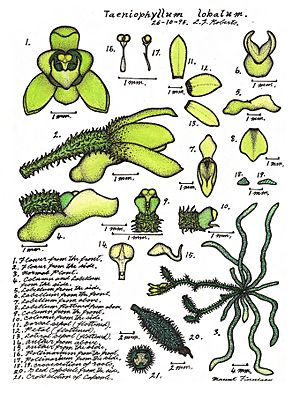Yellow ribbonroot facts for kids
Quick facts for kids Yellow ribbonroot |
|
|---|---|
 |
|
| Illustration by Lewis Roberts | |
| Scientific classification | |
| Genus: |
Taeniophyllum
|
| Species: |
lobatum
|
| Synonyms | |
|
Taeniophyllum flavum Dockrill |
|
The yellow ribbonroot (Taeniophyllum lobatum) is a special kind of orchid that doesn't have leaves. It grows on other plants or rocks. This orchid forms small groups and has short stems. Its roots are flat and pale green or grey-green. They press tightly against whatever the plant is growing on. Usually, it has two bright yellow flowers. You can only find the yellow ribbonroot in tropical North Queensland, Australia.
What it Looks Like
The yellow ribbonroot is a plant that grows without leaves. It can grow on trees (this is called epiphytic) or on rocks (this is called lithophytic). It forms small bunches. The stem of this plant is very tiny, only about 1 millimeter (0.04 inches) long.
Its roots are flat and pale green to grey-green. These roots are special because they do the job of leaves, making food for the plant using sunlight. They are about 30-80 millimeters (1.2-3.1 inches) long and 3-5 millimeters (0.12-0.20 inches) wide. They stick closely to the surface where the plant lives.
The yellow ribbonroot usually has two pale to bright yellow flowers. These flowers are small, about 3 millimeters (0.12 inches) long and wide. They grow on a white, hairy stem that is 5-15 millimeters (0.20-0.59 inches) long. The flower parts, called sepals and petals, spread out wide. They are about 2.5 millimeters (0.098 inches) long and 1 millimeter (0.039 inches) wide. They have tiny hairs near their base.
The main part of the flower, called the labellum, looks like a small boat. It is about 2 millimeters (0.079 inches) long and 1.5 millimeters (0.059 inches) wide. It has three parts, or lobes. The side lobes stand up and curve inwards, touching each other. The middle lobe has a small tube-like part called a spur, which is about 1 millimeter (0.039 inches) long. The yellow ribbonroot flowers from August to November.
Discovery and Name
The yellow ribbonroot was officially described for the first time in 1956. A scientist named Alick Dockrill gave it its scientific name, Taeniophyllum lobatum. He published his description in a science magazine called The Victorian Naturalist.
The second part of its name, lobatum, comes from a Latin word, lobus. This word means "a long part that sticks out." This name refers to the large side parts (lobes) of the flower's labellum.
Where it Lives
The yellow ribbonroot mostly grows on the smallest branches of trees in rainforests. Sometimes, you can also find it growing on rocks. It lives in Queensland, Australia. You can find it in the area between the McIlwraith Range and a town called Paluma.

